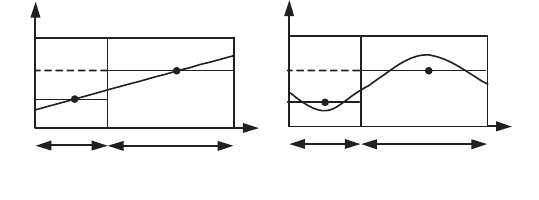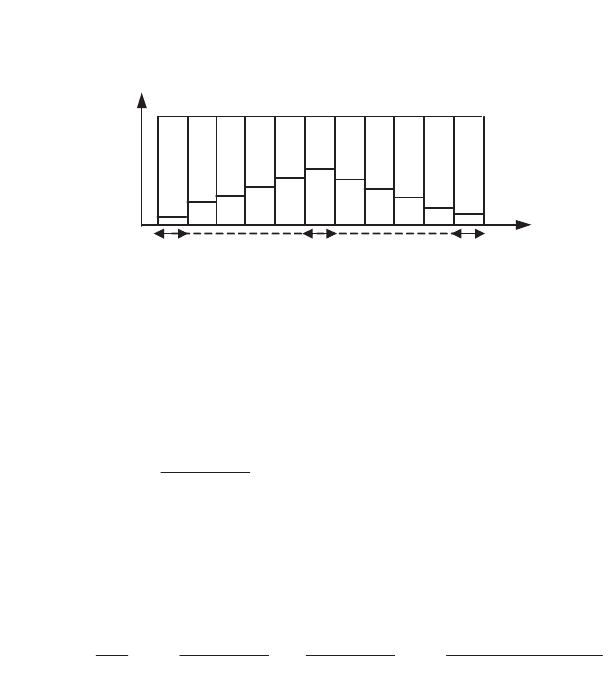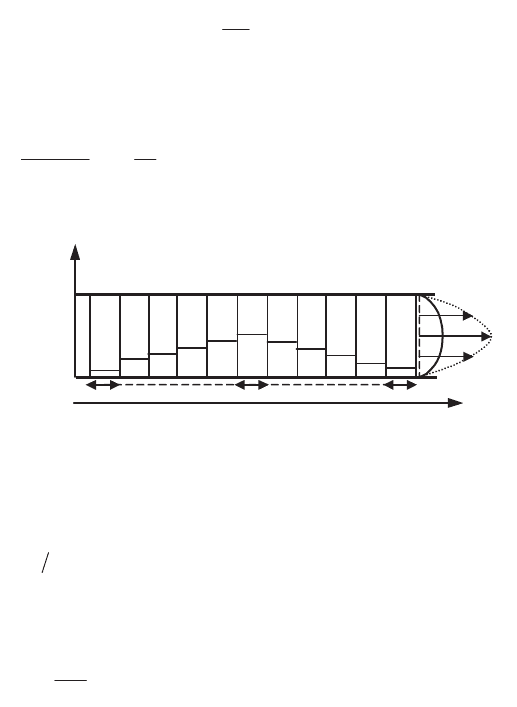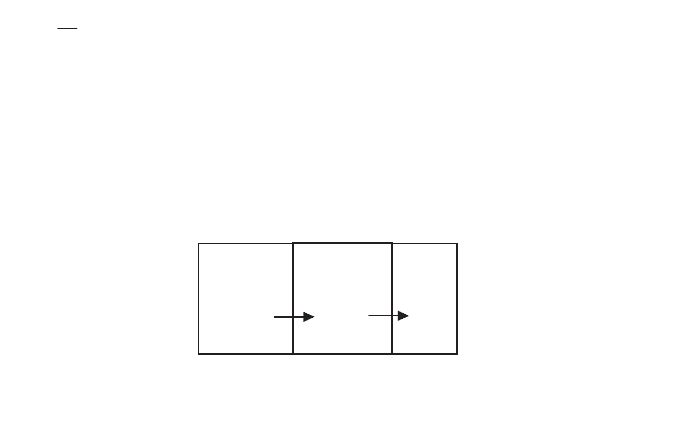Peube J-L. Fundamentals of fluid mechanics and transport phenomena
Подождите немного. Документ загружается.


Thermal Systems and Models 413
8.2.1.2.
Intensive variables and thermodynamic fluxes
We have seen that if the extensive variables of a system or a sub-system are
always defined, the same is not necessarily true of the intensive variables that only
have meaning if the system is in equilibrium. The complete
thermodynamic
representation
consists of representing the system with sufficient details, such that
each of the elementary sub-systems is close to a state of instantaneous equilibrium.
This condition is fulfilled if the size of the elements is not too great. For a finite sub-
system which is never rigorously in equilibrium, we have discussed the way to
define the mean intensive quantities (section 1.4.2.5 and section 6.5.2.4).
T
x
A
1
A
2
T
1
T
2
T
x
A
1
A
2
T
1
T
2
M
1
M
2
M
1
M
2
(a)
(b)
Figure 8.3.
Thermal flux between two neighboring elements
The behavior laws necessary to close the system of equations of the system
create a particular difficulty, as the thermodynamics fluxes which cross a surface are
related to the local gradients of the intensive quantities of the local continuous
medium. The problem is thus to express these by means of the intensive quantities
of the neighboring sub-systems. There is no general solution to this problem. Let us
take as an example the thermal resistance between two elements. Consider a fixed
1D continuous medium which is modeled as two blocks E
1
and E
2
which are
homogenous and of width
A
1
and
A
2
(Figure 8.3). For a fixed homogenous medium,
the mean temperatures
T
1
and
T
2
of each element are defined here by taking the
mean of the temperatures. Attributing the mean temperature to the central points of
the elements may appear natural. However, if the temperature gradient at the
interface is equal to the slope of the segment M
1
M
2
in the temperature distribution
of Figure 8.3a, the same is not necessarily so in the case of Figure 8.3b.
The segmentation of the continuous medium is acceptable for the thermal
imbalance of the first case, whereas it is too coarse for that of the second case. We
encounter here a usual interpolation problem.

414 Fundamentals of Fluid Mechanics and Transport Phenomena
The modeling of thermal fluxes between the two sub-systems requires in
addition a
suitable
discretization
of the intensive quantities between two neighboring
sub-systems
. Let us consider two examples:
1) Consider a
1D solid
(Figure 8.4) subjected to a conductive thermal flux and
discretized into
n
elements E
i
of uniform thickness
e
and temperature
T
i
.
(i=1,2,…,n). The element E
i
is characterized either by its energy
Q
i
or by its mean
temperature
T
i
:
i
x
x
i
CeTCdTQ
n
n
UU
³
1
T
1
E
n-1
E
n
E
i-1
E
i
E
2
E
1
E
i+1
T
2
T
n
T
n-1
T
i+1
T
i
T
i-1
T
e e e
x
Figure 8.4.
Model of a 1D thermal transfer
We must now express the thermal fluxes between two neighboring elements.
Assuming that the middle of each element is at temperature
T
i
, we can write the
thermal flux
q
T
i,i+1
received by E
i
from E
i+1
:
e
TT
q
ii
iTi
1
1,
O
We note that this expression satisfies the principal of action and reaction
(
1, 1,Ti i Ti i
qq
) associated with the conservation of energy. If there is no lateral
thermal flux, the balance equation can be written for each element E
i:
e
TTT
e
TT
e
TT
dt
dT
Ce
iiiiiiii 1111
2
OOOU
[8.3]
2) Consider the established flow of a fluid in a cylindrical pipe. We assume, in
order to simplify matters, that the flux and the physical properties of the fluid are
constant.

Thermal Systems and Models 415
We have seen (section 6.5.2.2) that the balance equation of a quantity g in a pipe
can be written by means of surface integrals on a cross-section and an integral over
the contour of this section ([6.82]). We thus consider a cutting out of the pipe into n
surfaces S
i
with an inter-surface spacing of e (Figure 8.4). Let ),( Mtu and ),( MtT
be the velocity and temperature distributions in the cross-section; we define below
the mean temperature T
i
and the mean mixing-temperature T
mi
for the section S
i
:
³³
Si
v
mi
Si
i
Tdsu
q
tTTdstT
1
;
The energy balance in the pipe can be written ([6.87]):
³³³³
w
w
w
w
C
TpT
S
dqdsuCTds
x
ds
t
CT
A
SS
VU
U
T
1
T
2
T
n
T
n-1
T
i+1
T
i
T
i-1
S1
E
n-1
E
n
E
i-1
E
i
E
2
E
1
E
i+1
S
2
S
n
Sn-1Si+1SiSi-1
e e e
x
u(t,M)
S
T
Figure 8.5.
Model of a pipe flow with thermal transfer
The calculation of the convective thermal flux between two successive surfaces
must be realized from upstream to downstream of the flow (section 5.6.1) and the
derivative
xww should be discretized between the sections S
i-1
and S
i
. Let T
pi
be the
temperature of the wall associated with the surface S
i
; the preceding equation [6.87]
can thus be written:
mipiimimv
i
TTheTTCq
d
t
dT
CSe
FUU
11
[8.4]
where we denote by
F
the perimeter of the cross-section. The exchange coefficient h
between the fluid and the wall is defined as a function of the mean mixing-
temperature T
mi
; its value depending on the considered problem is obtained from
experiments or theoretical evaluation in neighboring problems ([SCH 99], [YIH
77]).

416 Fundamentals of Fluid Mechanics and Transport Phenomena
8.2.1.3. Balance equations for the sub-systems
The writing of balance equations for a system is not necessarily associated with
the cutting out which is chosen in order to model the n disconnected sub-systems.
Each finite sub-system is characterized by the extensive quantity G which it contains
and the flux
M
SG
which it receives from the neighboring sub-systems. The balance
equations for the extensive mass quantity g in a domain S can be written ([2.7]):
³³
w
w
S
GSG
S
dvgdv
t
VMU
The extensive quantity of a system is obviously the sum of the corresponding
extensive quantities of its sub-systems only if these are disjoint. For two such sub-
systems, such as S
1
and S
2
, we have:
³³³
2121 SSSS
gdvgdvgdv
UUU
S
1
S
2
M
12
M
23
S
3
b
alance equation S
1
balance equation S
2
balance equation S
3
b
alance equation S
1
balance equation (S
2
*
S
3
)
balance equation (S
3
*
S
1
)
b
alance equation S
1
balance equation (S
2
*
S
3
)
Figure 8.6.
Balance equations for three material adjacent sub-systems
The balances can be obtained for sub-systems which are partially over-lapped.
Figure 3.6 shows the case of three contiguous sub-systems S
1
, S
2
and S
3
: the sub-
system S
2
S
3
overlaps S
2
, but it is possible to write the balance equations for the 3
disjoint sub-systems or for the three ensembles of sub-systems different two by two.
This manner of proceeding is nonetheless limited by the fact that the system of
equations obtained must be suitably enough conditioned (section 7.2.7.3), each
equation providing specific and sufficient information. The sum of the internal
fluxes exchanged between the sub-systems is zero (principle of action and reaction).
In the construction of models and numerical schemes we must be careful that this
property is ensured (conservative scheme).

Thermal Systems and Models 417
8.2.1.4. Coupling coefficients between two sub-systems
Consider a system comprising n sub-systems E
i
characterized by their extensive
quantities g
i
and their associated intensive energy quantities, or an equivalent (for
example, quantity of heat and temperature). Let us assume that two elements i and j
exchange a flux of the quantity g under the effect of a difference the intensive
quantity
ji
yy
. The flux
ijij
yy
N
of the quantity x received from the element
j by the element i is opposed to the flux
jiji
yy
N
of the quantity x received from
the element
i by the element j (action and reaction) and the positive coefficients
N
ij
and
N
ji
are equal. The balance equations of the quantity g for these two sub-systems
can be written:
!!!!
jiji
j
ijij
i
yy
dt
dg
yy
dt
dg
NN
;
or, by classing the terms:
!!!!
iji
j
jij
i
y
dt
dg
y
dt
dg
NN
;
Denoting by
U the group of sources of the quantity g
i
and defining the state
vectors
G and Y of the extensive quantities g
i
and the corresponding intensive
quantities
y
i
, the balance equations can be written in the general form:
UJYK
dt
dG
[8.5]
The matrix
J translates the importance in each element of the external
contributions. As the
coupling coefficients
N
ij
and
N
ji
between the elements i and j
are equal, the matrix K is symmetric. This feature is not a general constant, since the
coefficients of
N
ij
are functions of the state variables of the elements i and j.
So, the extensive variable
g
i
and the intensive variable y
i
of a sub-system are
related by a state equation. Passage to the form [8.1] of the state representation of
the system can often be realized in thermal systems by expressing in each of the sub-
systems the
extensive variable g
i
as a function of the only corresponding intensive
variable y
i,
iii
ygg
.
By defining the diagonal matrix
'
of positive elements
iiijij
dydgd
G
, we have in this case:

418 Fundamentals of Fluid Mechanics and Transport Phenomena
d
t
dY
d
t
dG
'
[8.6]
Letting
Y = X, system [8.5] can be written in the form [8.1]:
. :with.
11
JBKABUXA
d
t
dX
' '
[8.7]
It is easy to verify that the matrix
KA .
1
' of equation [8.1] is not symmetric,
except if the value of each element d
ij
is independent of the index i (identical sub-
systems). The reader can verify these considerations by means of the example in
section 8.3.1.3 by comparing equations [8.23] and [8.24] (or [8.28] and [8.29]). The
importance of this property for the linear case is discussed in section 8.2.2.2.
8.2.1.5.
Equivalence of inputs and initial conditions
Inhomogenous system [8.8] with impulse inputs, but with zero initial conditions,
can be reduced to a homogenous system with non-zero initial conditions. Let us
verify this point in an elementary manner using second order differential equation
[8.8] with zero initial conditions and having a Dirac distribution
tc
G
at instant 0 as
the input:
000)(
1
xxtctxtxatx
G
[8.8]
By integrating between 0 and a small time
H
and assuming that the functions
txandtx
remain bounded, we obtain:
H
H
H
oxcx )(
Problem [8.8] is thus reduced to a homogenous problem with an initial condition
at the instant
H
:
cxoxtxtxatx
H
H
H
,;0)(
1
[8.9]
Letting
H
tend to zero, we obtain the equivalent problem [8.10]:
cxxtxtxatx 0,00;0)(
1
[8.10]
The mechanical interpretation of this result (sometimes known as Schwartz’s
theorem) is clear, given an initial velocity c is equivalent to the application of an
impulse which produces this velocity at the initial instant.

Thermal Systems and Models 419
The reader can verify in the same way that non-linear problem [8.11] is
equivalent to problem [8.12]:
00.)(.
0
XtXtUBtXXA
d
t
dX
G
[8.11]
0
0.)(. XXtUBtXXA
d
t
dX
[8.12]
We can replace the initial conditions with these additional impulse inputs which
act on the state variables. In certain cases, these can be realized by acting on the
existing inputs U, except if the number of state variables n is greater than the
number of independent inputs. In summary, it is often not possible to make clear
conceptual distinctions between inputs and initial conditions (or boundary
conditions) such that they appear in the mathematical representation of a model.
8.2.1.6.
Modeling and numerical solution of equations for continuous media
We have reasoned so far in the context of “thermodynamic” modeling of systems
by means of an ensemble of discrete sub-systems which are each in a state of
thermodynamic quasi-equilibrium. Other approaches are possible for obtaining
discretized equations from the balance equations for continuous media:
– finite difference methods consist of discretizing the domain under study and
replacing the differential operators at the points of the grid thus obtained with finite
difference operators;
– finite element methods represent the local solution by simple algebraic
functions in very small sub-domains; the balance equations are integrated in the
domain after multiplication by the weighting functions, n being the number of
unknown parameters defining the ensemble of local solutions. Integrations by parts
often allow the reduction of the order of the necessary derivatives, and the use of
finite elements of standard form allows the realization of very general calculatory
procedures. We thus obtain an integral formulation comprising n integral conditions
for the determination of n unknowns;
– finite volume methods consist of the definition of finite elements in which the
balance equations are integrated; the approximations of the solution in each element
are simple algebraic functions.
In all cases, we obtain a system of equations which is analogous to the state
representation, the preceding numerical schemes belong to two broad categories
depending on whether they are conservative or not (a numerical scheme is said to be
conservative if the discretized equations exactly satisfy the balance of an extensive

420 Fundamentals of Fluid Mechanics and Transport Phenomena
quantity with the variables which are used to represent the system). A conservative
scheme avoids the amplification of numerical errors which are integrated into the
balance of physical quantities. It cannot of course correct the unstable character of a
physical system. The finite element method is not conservative, contrary to the finite
volume method. Finite difference schemes may or may not be conservative. Finally,
it is important to remember that, regardless of the method used for discretizing the
equations, numerical schemes and algorithms used should respect the rules of
transmission of information from one point or element to another which results from
the character elliptic, hyperbolic, parabolic or mixed of the equations (section 5.6.1).
8.2.2. Linear time-invariant system (LTIS)
8.2.2.1. Introduction
Differential system [8.7] for A constant and with initial conditions can be
written:
0
0,.. XXUBXA
d
t
dX
[8.13]
The linearity of equation [8.13] makes it possible to use the usual methods of
solving linear differential equations. The solution is the sum:
– of a particular solution
)(tX
e
of the complete system [8.14]:
UBXA
d
t
dX
e
e
.. [8.14]
– and a solution
)(
ˆ
tX of the homogenous system [8.15] adjusted such that the
solution satisfies the initial conditions:
0
00
ˆ
,
ˆ
.
ˆ
XXXXA
d
t
Xd
e
[8.15]
The solutions of the homogenous system [8.15] are real decaying exponentials or
damped sinusoidal functions if the system is stable. They represent
transitional
regimes
.
A particular solution
)(tX
e
is often chosen so as not to contain transitional
terms and represents an
established regime of the problem treated (assumed stable),
independent of the initial conditions. This established regime plays a very important
role in numerous cases, in particular when the inputs are either simple algebraic

Thermal Systems and Models 421
functions of time or harmonic excitations. This particular solution can be obtained in
general by the variation of constants method (see mathematical texts).
The separation between transitional and established solutions is no longer
theoretically so clear for
non-linear systems; it can however be useful in numerous
cases, as dissipation phenomena are often associated with a progressive elimination
of the initial conditions, except of course in the case of a multiplicity of established
solutions (section 6.6.2).
The above result can be immediately transposed to partial differential equations.
In this case the particular solution
tX
e
of the inhomogenous equation should
satisfy all the zero and non-zero boundary conditions, the solutions of the
homogenous equation satisfying zero boundary conditions. The solution obtained for
the homogenous equation is chosen such that the complete solution satisfies the
initial conditions.
8.2.2.2.
Recall on transitional regimes
The general solution of homogenous equation [8.15] is a linear combination of
terms of the form
t
e
/
4 ,
/
being a solution of the eigenvalue problem:
0unitmatrix AI I/4 [8.16]
Equation [8.16] only has non-zero solutions for particular values
/
i
, which are
known as eigenvalues, of which there are
n, including their eventual multiplicity.
For each value
/
i
the solutions of equation [8.16] are of the form
ii
c 4 , where 4
i
is
an eigenvector associated with the eigenvalue
/
i
(c
i
is some constant). An
eigenvalue and its associated eigenvectors are known collectively as a mode. The
eigenvalues are real and negative for aperiodic modes (in thermal systems in
particular) or complex with a real part which may be negative for oscillatory damped
modes or zero for unamped modes (in acoustics for example). By limiting ourselves
here to thermal systems, the eigenvalues
tX
i
ˆ
can be written:
ttX
iii
/4 exp
ˆ
The complete solution of a given problem is thus written:
¦
/4
n
i
iiie
tctXtXtXtX
1
exp
ˆ
:with
ˆ
[8.17]
The scalar coefficients
c
i
are calculated from the initial condition
0X which is
assumed to be known:

422 Fundamentals of Fluid Mechanics and Transport Phenomena
¦
4
n
i
iie
cXX
1
00 [8.18]
The transitional regimes are solutions comprising the return to rest of the
homogenous system (or to the established regime
)(tX
e
of the system with a right-
hand side) from non-zero initial conditions (or eventually zero for an established
regime )(
tX
e
). Having determined the eigenvectors 4
i
, the coefficients c
i
are
solutions of linear system [8.18], the matrix of which is full; for a large number
n of
equations this system is ill-conditioned (section 7.2.7.3). However, if a scalar
product exists
! VU for which the matrix A is self-adjoint
(
!! VAUVUA ), the eigenvalues 4
i
are orthogonal (taking account of
[8.16], if
ji
/z/
, we have 0
11
! 44/! 44/! 44
jijjiiji
AA ).
For the scalar product
UVVUVU
tt
' ' of the vectors U and V , defined
with the diagonal matrix
'
(relation [8.6]), K being symmetric, this leads to:
! '' '' '!
VAUKVUKVUVKUVAUVUA
tttttt 11
We can deduce from this, in a manner analogous to that outlined in section
A.4.2.2 of Appendix 4:
i
t
ii
t
ei
XXXXXc ..00 ''
NOTE
–
Expression [8.17] is the development at instant t of the function
ˆ
X
t on
the basis of eigenfunctions
4
i
with instantaneous coefficients
exp
ii
ct/ . After a
time lapse
t, which is large compared to 1//
J
, the mode j is no longer present in the
transitional solution; its coefficient there being equal to zero, this gives:
0..
ˆ
4' 4'
j
t
ej
t
tXtXtX [8.19]
8.3. Modeling linear invariant thermal systems
8.3.1. Modeling discrete systems
8.3.1.1. Introduction
The fundamental problem is the reasoned choice of the number of sub-systems
or the variables necessary for representation of a system, the number of variables
